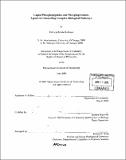Caged phosphopeptides and phosphoproteins : agents in unraveling complex biological pathways
Author(s)
Rothman, Deborah Maria
DownloadFull printable version (8.457Mb)
Other Contributors
Massachusetts Institute of Technology. Dept. of Chemistry.
Advisor
Barbara Imperiali.
Terms of use
Metadata
Show full item recordAbstract
Within cellular signaling, protein phosphorylation is the post-translational modification most frequently used to regulate protein activity. Protein kinases and phosphoprotein phosphatases generate and terminate these phosphoryl signals, respectively. Chemical approaches for studying protein phosphorylation and the roles of phosphoproteins include photolabile caged analogs of bioactive species. Caged compounds are ideal chemical probes for studying cellular signaling because they afford researchers spatial and temporal control over the release of targeted effector molecules. Ligands or proteins involved in signal transduction can be chemically caged and subsequently irradiated to release a concentration burst of a specific species, allowing the downstream effects to be monitored without disrupting other aspects of the system. The syntheses and applications of caged phosphopeptides and phosphoproteins have been developed and detailed within this thesis. Two methods to synthesize 1-(2-nitrophenyl)ethyl caged phosphopeptides were developed. These peptides demonstrated good quantum yields of uncaging as compared to literature values of other ortho-nitrobenzyl derived caged compounds. A study in which these caged phosphopeptide tools yielded seminal information about the 14-3-3 protein family's involvement in cell cycle control successfully demonstrated the unique utility of these probes. Furthermore, the synthesis that allowed the extension of the nonsense codon suppression methodology to include caged phosphoproteins was developed. (cont.) The three most commonly phosphorylated amino acids (serine, threonine, and tyrosine) were each incorporated into a test protein in their caged phosphorylated form. Toward studying cell motility, caged phosphoserine was incorporated into position 153 of mVASP for use in live cell assays.
Description
Thesis (Ph. D.)--Massachusetts Institute of Technology, Dept. of Chemistry, 2005. Vita. Includes bibliographical references.
Date issued
2005Department
Massachusetts Institute of Technology. Department of ChemistryPublisher
Massachusetts Institute of Technology
Keywords
Chemistry.